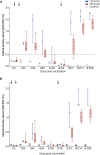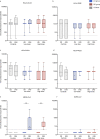Increased neutralization and IgG epitope identification after MVA-MERS-S booster vaccination against Middle East respiratory syndrome
- PMID: 35853863
- PMCID: PMC9295877
- DOI: 10.1038/s41467-022-31557-0
Increased neutralization and IgG epitope identification after MVA-MERS-S booster vaccination against Middle East respiratory syndrome
Abstract
Vaccine development is essential for pandemic preparedness. We previously conducted a Phase 1 clinical trial of the vector vaccine candidate MVA-MERS-S against the Middle East respiratory syndrome coronavirus (MERS-CoV), expressing its full spike glycoprotein (MERS-CoV-S), as a homologous two-dose regimen (Days 0 and 28). Here, we evaluate the safety (primary objective) and immunogenicity (secondary and exploratory objectives: magnitude and characterization of vaccine-induced humoral responses) of a third vaccination with MVA-MERS-S in a subgroup of trial participants one year after primary immunization. MVA-MERS-S booster vaccination is safe and well-tolerated. Both binding and neutralizing anti-MERS-CoV antibody titers increase substantially in all participants and exceed maximum titers observed after primary immunization more than 10-fold. We identify four immunogenic IgG epitopes, located in the receptor-binding domain (RBD, n = 1) and the S2 subunit (n = 3) of MERS-CoV-S. The level of baseline anti-human coronavirus antibody titers does not impact the generation of anti-MERS-CoV antibody responses. Our data support the rationale of a booster vaccination with MVA-MERS-S and encourage further investigation in larger trials. Trial registration: Clinicaltrials.gov NCT03615911.
© 2022. The Author(s).
Conflict of interest statement
The authors declare no competing interests.
Figures






Similar articles
-
Safety and immunogenicity of a modified vaccinia virus Ankara vector vaccine candidate for Middle East respiratory syndrome: an open-label, phase 1 trial.Lancet Infect Dis. 2020 Jul;20(7):827-838. doi: 10.1016/S1473-3099(20)30248-6. Epub 2020 Apr 21. Lancet Infect Dis. 2020. PMID: 32325037 Free PMC article. Clinical Trial.
-
Recombinant Receptor-Binding Domains of Multiple Middle East Respiratory Syndrome Coronaviruses (MERS-CoVs) Induce Cross-Neutralizing Antibodies against Divergent Human and Camel MERS-CoVs and Antibody Escape Mutants.J Virol. 2016 Dec 16;91(1):e01651-16. doi: 10.1128/JVI.01651-16. Print 2017 Jan 1. J Virol. 2016. PMID: 27795425 Free PMC article.
-
Cross-Protection against MERS-CoV by Prime-Boost Vaccination Using Viral Spike DNA and Protein.J Virol. 2020 Nov 23;94(24):e01176-20. doi: 10.1128/JVI.01176-20. Print 2020 Nov 23. J Virol. 2020. PMID: 32967955 Free PMC article.
-
Prospects for a MERS-CoV spike vaccine.Expert Rev Vaccines. 2018 Aug;17(8):677-686. doi: 10.1080/14760584.2018.1506702. Epub 2018 Aug 9. Expert Rev Vaccines. 2018. PMID: 30058403 Free PMC article. Review.
-
Advances in MERS-CoV Vaccines and Therapeutics Based on the Receptor-Binding Domain.Viruses. 2019 Jan 14;11(1):60. doi: 10.3390/v11010060. Viruses. 2019. PMID: 30646569 Free PMC article. Review.
Cited by
-
Monkeypox Virus Cross-Neutralizing Antibodies in Clinical Trial Participants Vaccinated With Modified Vaccinia Virus Ankara Encoding Middle East Respiratory Syndrome-Coronavirus Spike Protein.J Infect Dis. 2023 Aug 31;228(5):586-590. doi: 10.1093/infdis/jiad052. J Infect Dis. 2023. PMID: 36857443 Free PMC article.
-
Dissecting humoral immune responses to an MVA-vectored MERS-CoV vaccine in humans using a systems serology approach.iScience. 2024 Jul 8;27(8):110470. doi: 10.1016/j.isci.2024.110470. eCollection 2024 Aug 16. iScience. 2024. PMID: 39148710 Free PMC article.
-
A recombinant Modified Vaccinia virus Ankara expressing prME of tick-borne encephalitis virus affords mice full protection against TBEV infection.Front Immunol. 2023 Apr 21;14:1182963. doi: 10.3389/fimmu.2023.1182963. eCollection 2023. Front Immunol. 2023. PMID: 37153588 Free PMC article.
-
Generating MVA-Vector Vaccine Candidates and Testing Them in Animal Models.Methods Mol Biol. 2025;2860:297-340. doi: 10.1007/978-1-0716-4160-6_20. Methods Mol Biol. 2025. PMID: 39621276
-
MVA-based vaccine candidates encoding the native or prefusion-stabilized SARS-CoV-2 spike reveal differential immunogenicity in humans.NPJ Vaccines. 2024 Jan 26;9(1):20. doi: 10.1038/s41541-023-00801-z. NPJ Vaccines. 2024. PMID: 38278816 Free PMC article.
References
-
- World Health Organization. Prioritizing diseases for research and development in emergency contexts, https://www.who.int/activities/prioritizing-diseases-for-research-and-de... (2021).
Publication types
MeSH terms
Substances
Associated data
LinkOut - more resources
Full Text Sources
Medical

